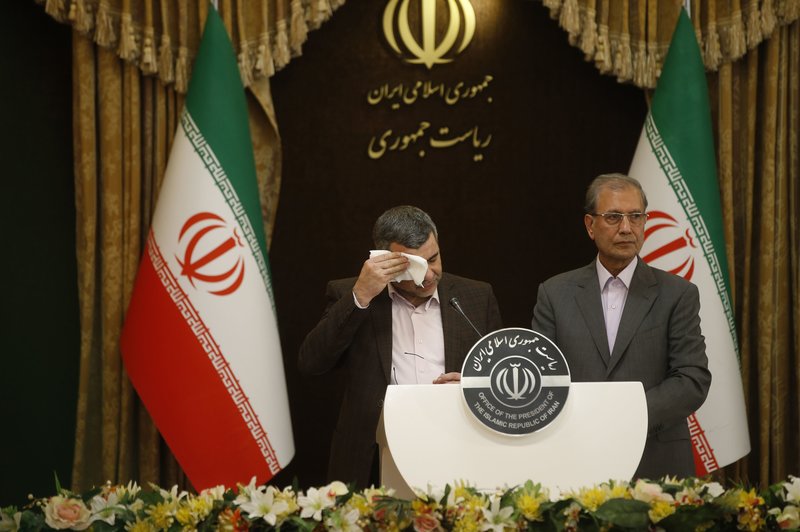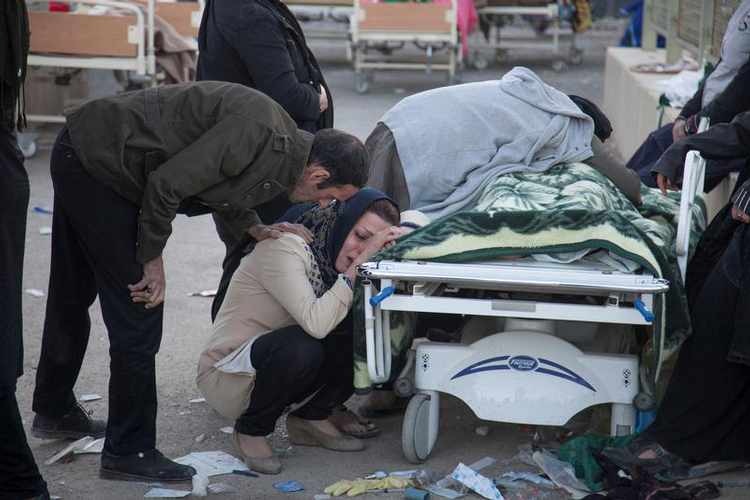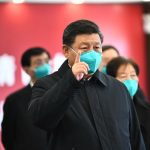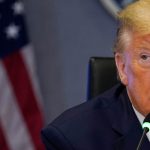INTERVIEWS
Date: 10 April 2020
Iran: a system on the verge of its capacity
Iran is one of the most affected countries in the world by the coronavirus pandemic. For a long time, the authorities have not taken drastic steps and considered the manifesto of national unity, such as the celebration of the 41st anniversary of the establishment of the Islamic Republic of Iran and the parliamentary elections, as more important. Despite the global crisis, the conflict with the United States has not lost its relevance either.

We invite you to read the interview with Marcin Krzyżanowski, former Consul of the Republic of Poland in Kabul and currently, a businessman operating in Iran.
This article was originally published in The Warsaw Institute Review on 01.04.2020.
Jarosław Walkowicz, The Warsaw Institute Review:
In recent months, much attention was paid to Iran, especially due to the fact that the US forces killed man number two – Gen. Qasem Soleimani. Today the country faces another challenge – the spread of the COVID-19 pandemic. What is the origin of the coronavirus pandemic in Iran? When were the first infected people diagnosed and were any countermeasures introduced?
Marcin Krzyżanowski: It is impossible to find a clear and indisputable answer to the question about the actual beginning of the coronavirus epidemic in Iran. The first official cases of COVID-19 infection, two at the same time, were recorded on February 19, this year, in the city of Qom, however, it should be assumed that in practice the virus reached Iran in the same way, but slightly earlier. The patient zero was most probably an Iranian entrepreneur who came back from China. Iran has very extensive economic relations, including, primarily trade, with China… Entrepreneurs from both countries travelled intensively, there was a large group of Chinese workers and engineers working on joint projects in Iran, and tourist traffic was quite intensive as well. An additional factor hindering the analysis of the beginning of the epidemic is the fact that it took place in a very sensitive period for Iran. The Iranian economy has long been in crisis due to sanctions, in November 2019, fuel protests took place in the country and on January 3, the Americans killed the mentioned General Soleimani, reinforcing the feeling of threat in the country and at the same time hitting the image of Iran in the world. Shortly afterwards, two events took place which were probably crucial for such a rapid epidemic spread in Iran. On February 11, the country celebrated its forty-first anniversary of the Islamic Revolution, which every year include mass rallies in support of the Islamic Republic; and parliamentary elections were held on February 21. The issue of the Iranian, or more precisely Shiite religious traditions, which involve visits and pilgrimages to the so-called imamzadeh, i.e. the sanctuaries built around the graves of Shiite Imams and their family members, is also significant. Thousands of people crowd in a small space, kissing the bars surrounding the tomb. Unfortunately, initially, no countermeasures were introduced, except for general warnings and attention to hygiene. Currently, the government’s actions are more decisive – the role of the armed forces and Basij militia is growing, limited bans on movement have been introduced, but most commentators consider such actions as belated. There were even bizarre situations in which citizens, who are reluctant to the authoritarian regime on a daily basis, started calling for more radical measures.

Were you and the Iranian citizens aware of the impending epidemic?
Around these parliamentary elections, when there were already dozens of people infected in Iran, public opinion began to show initial concern, but the vast majority of Iranians tended to disregard the new virus, although there were already the first cases of self-isolation and restrictions on professional activity among traders. In the following days, more cases were diagnosed, including one in Arak, which was the first evidence that the virus “left” the city of Qom, which turned out to be the Iranian source of the virus. At that time, more and more Iranians began to practice “social distancing”, more and more restaurants suspended their activities, and restrictions on the work of banks and offices started to be introduced. Although the main bazaar in Tehran remained open, the virus hit the headlines. The assurances about readiness for any scenario and calls for calm, which are widespread and obvious in such situations, were prevailing. Until February 27, the increase in the number of diagnosed infected people was relatively small in absolute numbers and amounted to 45-70 people per day, which meant an increase of about 40-60% every day. In the following days, new cases were counted in hundreds. The curve of infected people shot up after March 4. Official statistics show that since March 30, the daily number of new cases started to decrease, but still amounts to about two and a half thousand a day.

Are Iranian decision-makers trying to control or limit the development of the pandemic in their country?
Inappropriate management at the national level due to, among others, conflicts between different influence groups and Iran’s involvement in international conflicts complicated the government’s response to the coronavirus threat, resulting in an extremely rapid increase in the number of infections. It is widely believed that the authorities initially ignored the threat of the epidemic, but this is not far from the global norm at that time. However, while other countries affected by the epidemic eventually began to introduce significant movement restrictions, Iran has done nothing for a long time. Due to the resistance of a part of clergymen and the public, on March 16, which was quite late, the most important sanctuaries in Qom and Mashhad were closed, which caused minor riots after the crowd of believers invaded the temple courtyard by force. It was not until March 25 that official restrictions on movement between cities were introduced. Earlier, the authorities had limited themselves to appeals for common sense, which, to put it mildly, had a moderate effect in the face of the Iranian New Year celebrated on March 21. For fear of the state’s economy, Iran has adopted, among others, a tactic based primarily on the rapid detection of the virus and the isolation of the infected and attempts to quickly find an effective cure. Of course, there were also references to so-called herd immunity. Unfortunately, at the moment, the effects of the actions taken are poor. However, the government has taken decisive steps aimed at saving the economy. Prices were frozen very quickly, credit holidays were allowed and other solutions were proposed. In recent days, ayatollah Khamenei has agreed to release the currency reserves and to start paying the affected companies and people who have lost their jobs as a result of the epidemic.
The media are alarming about the falsification of official statistics by the Iranian government, so are we able to estimate how many people are actually infected and dead?
It cannot be excluded that they may be understated, but it is rather not a part of a broader policy. According to the official statistics, there are about 55 thousand infected and about 3,400 deaths. Estimates are around 78 thousand and 6 thousand respectively. The differences are significant, but it is not enough to change the picture. The Iranian statistics are far from the highest standard, and the Iranian administration is not fully transparent, but I wouldn’t look for any conspiracy or deliberate and systemic action in this case. The authorities openly admit that the situation is very difficult and the system is on the verge of its capacity. Personally, I am inclined to adopt an intermediate version, between the official statistics, which may be understated, and those reported by media hostile to the regime, which, in turn, may be overstated.

Are the Iranian authorities currently in control of the social situation and what is the role of the Islamic Revolutionary Guard Corps?
The authorities are in control of the social situation, although the number of people dissatisfied with the situation in the country is steadily increasing. There are regular riots. It should be remembered, however, that the idea of the Islamic republic, embodied by Rahbar ayatollah Khamenei, is strongly supported by society, often motivated by religion. Since 1979, Iran has been struggling with the, otherwise reasoned, besieged fortress syndrome. The feeling of threat from outside is very strong among the supporters of the Islamic Republic. Sepah, or the Islamic Revolutionary Guard Corps and its paramilitary militia, Basij, is responsible, as the name suggests, for guarding the revolution. Over time, Sepah has grown to the rank of what can be called a military-industrial complex with a religious-political foundation. This rather complicated term includes a complex system of family and business interrelationships, for which the Islamic Republic is the basis of existence. Since the war with Iraq, the influence of the Corps has been steadily increasing to reach its peak under M. Ahmadinejad’s presidency. Today, the Corps controls the vast majority of the Iranian economy through religious foundations and companies. The Corps is therefore both a defender of the regime and a privileged beneficiary of its existence.

Let us go back to six months ago. In November 2019, in Iran, protests caused by the rise in fuel prices broke out and lasted with breaks until January 2020. At that time, the authorities not only violently suppressed them, but also introduced restrictions in public space, such as the Internet blockade or a ban on visiting the graves of the dead protesters. What is the current relationship between the authorities and society in this context?
It depends on which layer or social group we are talking about. Iranian society is strongly and very deeply divided. The Islamic Republic has both its fanatical supporters and sworn enemies. It also has both tactical allies and tactical opponents. Somewhere in between these “active” groups, there is a very large group of people who are not emotionally involved in politics and are guided in their assessments by their interim interests. There is also a large part of the population that supports the Islamic Republic but is reluctant to the current authorities, which in their opinion “betrayed the revolution”. One must remember that the revolution was an Iranian movement. The Revolution was not “imported”, but was an Iranian product. There is also a large group of people who were completely politically passive, etc. The polarization of Iranian society is certainly growing. The alienation of groups reluctant to the republic that live “beside” it is also growing. At the same time, the authorities are consolidating the support of the proponents of the current order.
And what is the current state of the US-Iranian conflict, aggravated in January this year? Are the states continuing the conflict on a military level, or changed the tools used?
The answer to this question is extremely short – nothing has changed. Iran continues to support local militias in Iraq, Syria and Yemen, and continues to build its political influence in the region using non-kinetic forms of influence. The USA is still trying to stifle Iran economically in order to limit its opportunities and counteract Tehran’s activity on the international political level.

Why do Iranian decision-makers accuse the USA of causing a coronavirus crisis in their country? Are they accusing anyone else of infecting Iranians with the coronavirus?
One can rhetorically ask: who are they to accuse, if not the biggest enemy, especially in a situation where the real culprit is one of the few allies? This is the proverbial Realpolitik, part of which is propaganda or, depending on the side of the barricade, information policy. However, it is worth noting at this point that the accusations against the USA are, for Iranian conditions, rather reserved and addressed to a group of ardent supporters of the regime. Of course, there are supporters of conspiracy theories in Iran, but their percentage does not differ from the world standard. With a few exceptions, the narrative about the epidemic rather ignores the issues of causes and sources, focusing on the current situation and counteracting the effects of the epidemic. Of course, the media present the government’s actions positively and there is not much room for criticism of its actions.
What is the form of propaganda addressed to citizens and disinformation sent to the world by Tehran?
I would not use the term “disinformation”, or rather I would not limit its use to Iran alone. Iran is one of the parties in the regional conflict and, like the rest of its actors, it tries to highlight the sins of its opponents, diminishing or even omitting its own, at the same time putting itself in the role of the victim and defender of the oppressed. Of course, I do not put here a sign of equality between serious and relatively independent media from e.g. Europe and the Iranian media, which are subject to various restrictions, but, contrary to the messages coming from Riyadh and Washington, Iran is not an absolute evil.
When it comes to the internal propaganda, it is based primarily on recalling the harms that Iran suffered from the British first, then from the USA. The Ajax operation, which is the overthrow of Prime Minister Mosaddegh by MI6 and the CIA, the crimes committed by SAVAK secret police, corruption of the imperial government and American imperialism in general, have a prominent place in the message. A key element of the message, however, is Saddam Hussein’s assault on Iran in 1980 and the following war, called in official communications “the Imposed Qar”, or “the Holy Defense”. At the time, Iran fought alone against Iraq supported by both Western and communist blocs. The nation’s efforts to overthrow the empire and the “betrayal” of the USA, which broke the so-called “nuclear agreement”, are stressed. For the regime, American sanctions are a continuation of American aggression against Iran and an example of imperialism. American policy is often juxtaposed with Great Britain’s policy from before World War II.

Where can we place the attacks of Iranian hackers on various state and international institutions, including the WHO? Why are they doing it at such a difficult time for the whole world?
We can most likely recognise them as part of standard intelligence activities. The attacks in question are attempts to hack into e-mail accounts of the WHO employees. If we know about them, that means they have been rather ineffective or deliberately publicized. According to the information available, it is possible that they were not aimed at destabilizing the work of the WHO, but at discreetly gathering data. Of course, this is at least controversial, but however brutal it sounds, international politics knows no mercy, and knowledge is power. I do not want to look like an Iranian advocate, but it would be naive to think that only Tehran is trying to read emails of international organisations’ employees.
Do you see a chance for a thaw in Iran’s relations with the USA?
At the moment, there is no chance. Both sides, the USA and Iran, do not trust and accuse each other of being responsible for the mess in the Middle East. There is no hope for a change in internal policy either. We must remember that Tehran is a party in the Middle East conflict complex, but it is not the only party, and in the local reality, there are no simple boundaries between right and wrong.

So, what scenarios do you predict for the development of the current deadlock?
When it comes to possible scenarios, in the situation of the epidemic, it is rather groping in the dark, too many things can change dramatically in days or even hours. It is relatively certain that adversity and economic problems only strengthen the position of the conservatives, prevailing in the Iranian authorities, and cause mobilization of the regime supporters – and there are many of them. The alienation of a part of the Iranian society will intensify. Whatever the situation, the key question is how long the current leader will remain in office, who will be his successor and how quickly he will be elected. Low oil prices will certainly not help the Iranian economy, but the revenue from oil sales has been relatively low anyway. If the government manages to deal with rising unemployment and inflation, the situation will return to the status from before the epidemic. If not, the question about the attitude of the army and the Corps towards social protests, which will certainly break out if people have no food to eat, will arise. The emergence of an opposition leader, without whom any public appearance has no chance of success, will be the open question.
The situation in the region is unlikely to change, but the oil price will have a significant meaning there. Rich countries have more to lose. It is difficult to predict how the citizens of the authoritarian regimes of the Gulf will behave if social programmes are cut. The USA is unlikely to decide on a very costly armed conflict. The Pentagon has learned lessons from Afghanistan and Iraq, and the epidemic in the USA is becoming catastrophic in size. For now, the governments of the Middle East have to deal with a raging coronavirus pandemic, so this is not a good time to escalate conflicts. War is a very expensive activity. But if a symbolic event, similar to the assassination of General Soleimani or a major terrorist attack on the US forces happens, then the situation can easily get out of control.
An interview by Jarosław Walkowicz – The Warsaw Institute Review
Marcin Krzyżanowski – the Polish consul in Kabul in 2008-2011. Orientalist, Eastern affairs specialist and Afghanologist. Entrepreneur, traveller, university lecturer at the Jagiellonian University, living in Tehran.
This article was originally published in The Warsaw Institute Review on 01.04.2020.
The interview is a part of a series of The Warsaw Institute Review talks about the use of the crisis caused by SARS-CoV-2 in international politics.
All texts published by the Warsaw Institute Foundation may be disseminated on the condition that their origin is credited. Images may not be used without permission.















